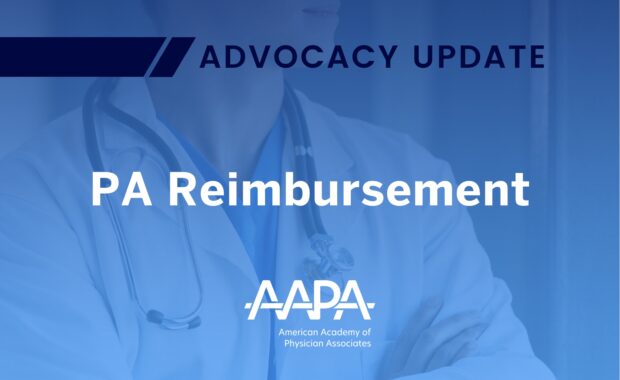Top 5 Most Popular CME from AAPA 2019
More than 160 Sessions Now Available on Demand
June 26, 2019
 If you couldn’t make it to Denver, Colorado, this year for AAPA 2019, we’ve got you covered! CME sessions from AAPA 2019 are now available online with Conference on Demand. You can earn more than 160 AAPA Category 1 CME credits online, anytime, anywhere. Here, we’ve highlighted the five most popular sessions from Denver.
If you couldn’t make it to Denver, Colorado, this year for AAPA 2019, we’ve got you covered! CME sessions from AAPA 2019 are now available online with Conference on Demand. You can earn more than 160 AAPA Category 1 CME credits online, anytime, anywhere. Here, we’ve highlighted the five most popular sessions from Denver.
- Optimal Outpatient Management of Hypertension: Choosing the Right Treatment for the Right Patient
The management of hypertension has become more challenging as a result of the recently published ACC/AHA Hypertension Guideline. The new guideline lowered the blood pressure target that defines hypertension, thereby substantially increasing the number of patients who are now hypertensive. Yet, even prior to these changes, management of hypertension in this country has been suboptimal with only about half of the hypertensive population achieving even the previous higher blood pressure targets. Among the causes for this shortcoming is inadequate clinician understanding of the pharmacology of antihypertensive medications and how to combine them to achieve optimal blood pressure control with the least side effects. After a brief review of key elements of the new guideline as they relate to their application in the office management of hypertension, this session outlines the effective, ineffective, and potentially harmful antihypertensive drug combinations and then illustrates these points through interactive case vignettes.
- Syncope Assessments in the Office, Emergency Department, or Hospital: Effective, Efficient, and Economic Evaluation
Syncope and other causes of transient loss of consciousness (t-LOC) are seen commonly in the emergency department as well as outpatient and inpatient settings. While benign etiologies for syncope occur commonly, clinicians must accurately and efficiently identify when a patient presenting with syncope bears higher risk for morbidity and mortality. Current guidelines and risk stratification tools can assist clinicians in making appropriate and safe medical decisions in their patients presenting with syncope or t-LOC. This session uses a case-based interactive discussion to permit clinicians to effectively and safely triage and evaluate patients presenting after a syncopal episode.
- Seeing 20/20: How to Identify Sight-threatening Conditions
Prompt recognition and appropriate treatment of ocular urgencies is essential in the primary care setting when preservation of vision may depend on timely management. A thorough history and examination coupled with the recognition of key clinical findings can help primary care PAs make sight-preserving decisions. Quickly evaluating, diagnosing, and managing sight-threatening conditions is an important skill set for PAs to possess to provide up-to-date standards of care. In this session a step-wise evidence-based approach for evaluation of possible sight-threatening conditions is covered followed by a rapid-fire diagnostic challenge in the form of clinical vignettes.
- Sepsis and Septic Shock
Although sepsis outcomes have improved in recent years, overall morbidity and mortality remain high. Sepsis is common but is frequently unrecognized by clinicians at initial presentation. This leads to delay in treatment and poor outcomes. The Third International Consensus Definitions for Sepsis and Septic Shock, otherwise known as Sepsis-3, has updated and simplified definitions, focusing clinical criteria on organ dysfunction. These simplified definitions and diagnostic criteria are easy to apply in any setting and give providers the tools to quickly recognize sepsis and start treatment immediately. This session focuses on the early recognition of sepsis and management strategies to decrease mortality.
- An Update on Asthma Guidelines and Treatment
The 2018 Global Initiative for Asthma (GINA) Guidelines are the most current and up-to-date asthma diagnosis and treatment guidelines available. This session outlines the GINA guidelines for the diagnosis of asthma, the correct staging of asthma, and the most recent recommendations for the treatment of asthma. It also highlights what is new in asthma diagnosis and treatment based on the GINA guidelines for 2018.
Check out Conference on Demand now to access these CME and over 150 more! Whatever your specialty or interests, you’ll be sure to find sessions that interests you. Additionally, AAPA’s Learning Central offers an array of CME opportunities from live CME events, to e-learning modules. If you’re ever looking for CME, AAPA’s Learning Central is your one-stop shop.
More Resources
AAPA’s Learning Central
Adult Hospital Medicine Boot Camp
Thank you for reading AAPA’s News Central
You have 2 articles left this month. Create a free account to read more stories, or become a member for more access to exclusive benefits! Already have an account? Log in.
